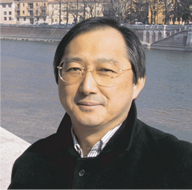Professor Satoru Miyano
Profile
Satoru Miyano, Ph.D., is a Professor of Human Genome Center, Institute of Medical Science, The University of Tokyo. He received the B.S., M.S. and Ph.D. all in Mathematics from Kyushu University, Japan, in 1977, 1979 and 1984, respectively. He joined Human Genome Center in 1996.
The recent advances in biomedical research have been producing large-scale, ultra-high dimensional, ultra-heterogeneous data. His mission is to create computational strategy for systems biology and medicine towards translational bioinformatics. The supercomputer system is the indispensable infrastructure for this mission. His activites are characterized by the following items:
- Gene network analysis: His group has been develping a series of computational methods for mining gene networks from DNA microarry gene expression data and various genome-wide information such as protein-protein interactions, etc. Bayesian networks, state space model, and Boolean networks are investigated for modeling, estimating and analyzing gene networks consisting of several thousands genes. This gene network technology has been applied for searching drug-response pathways. As a case, it was applied to HUVEC microarray data of more than 350 siRNA gene knock-downs and the computationally inferred HUVEC networks unraveled some hub genes regulating inflammation and apoptosis in TNF-alpha treated HUVEC.
- Modeling and simulation of biological systems: His group has been developing a software tool Cell Illustrator (CI) (http://cionline.hgc.jp/) with which we can model and simulate various biological mechanisms and pathways in cells by organizing and compiling biological data and knowledge, and an XML format Cell System Markup Language (CSML) (http://www.csml.org/) for describing biological systems with dynamics and Cell System Ontology (CSO). Since CI employs CSML/CSO and equips biology-oriented sophisticated GUIs, we can model very complex biological processes like with a drawing tool.
- Peta flops computing for biomedical applications: Since 2006, his group has been involved with the RIKEN's grand challenge project for life sciences called "Next-Generation Integrated Simulation of Living Matter". We are developing (i) peta-scale computational methods for inferring molecular networks of tens of thousands nodes, and (ii) a new statistical and computational method called “data assimilation” that “blends” simulation models and observational data rationally.
- International leadership in bioinformatics and computational biology: He organized the International Conference on Genome Informatics for 11 years since 1996. he served as program committee chairs and members for the most important international conferences on bioinformatics and computational biology such as RECOMB, ISMB, ECCB, APBC, CSB, etc. He also has been serving on editorial boards of PLoS Computational Biology, Bioinformatics, J. Computational Biology and Bioinformatics, IEEE/ACM Transactions on Bioinformatics and Computational Biology, etc.

